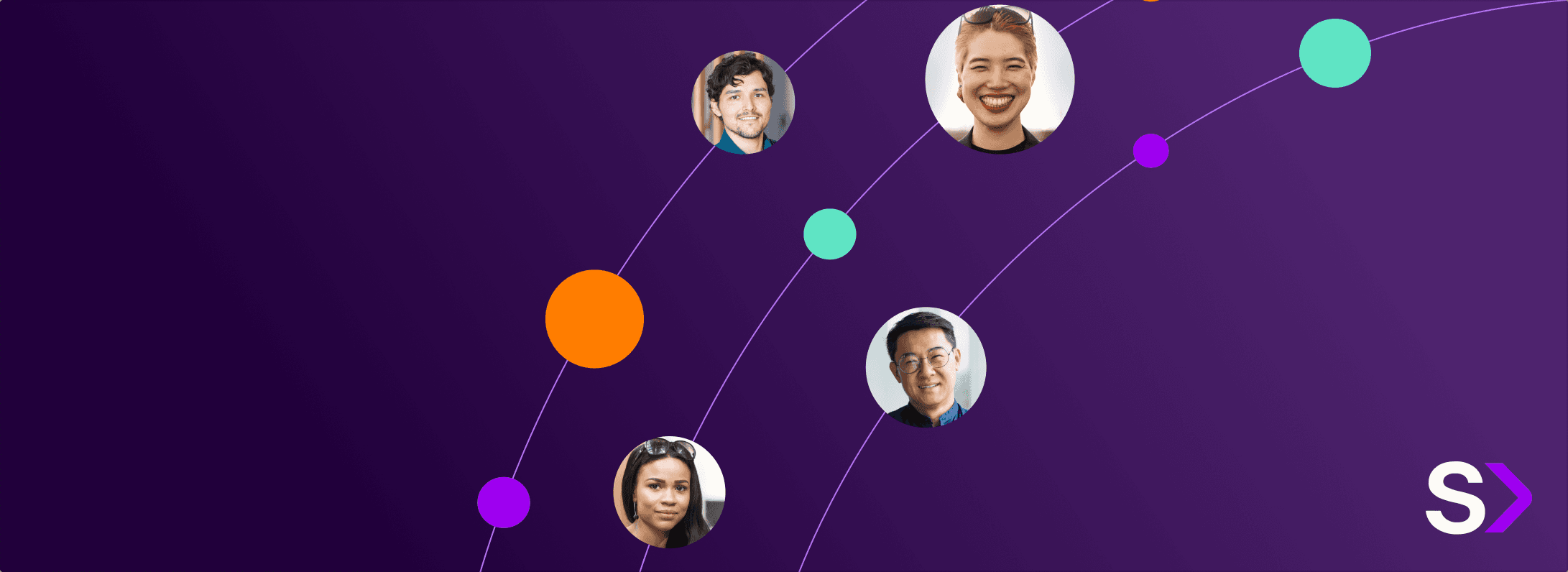
Back to blogs
We’ve entered an era where artificial intelligence (AI) is now talked about more than ever before. While AI itself has already been used by businesses and researched for decades, the launch of recent generative AI tools like ChatGPT have propelled the technology into mainstream chatter—and deeper into the daily orbit of talent teams.
As generative AI’s popularity soars, so does a breadth of new use cases and conversations around how the technology will transform work. Many talent leaders are eager to understand the technology and how other AI tools can benefit their teams. According to Gartner, 81% of human resource leaders have explored or implemented AI solutions to improve process efficiency within their organizations. But with such high adoption and willingness to learn, many are still left with concerns about either introducing or adding more AI tools into their hiring process and what the technology means for the future of talent acquisition.
Top 10 ChatGPT Prompts for Recruiters
Download NowThe volume of AI news is overwhelming to keep up with, and some questions we all have about AI have yet to be answered simply because we can’t predict the future. This ambiguity creates noise that may have led you to believe—or at least hear about—myths surrounding AI and recruiting that shouldn’t be taken at face value.
Ahead, we’ll look into five common myths, why they may be prevalent, and shed light on the truths behind them given the information available today about AI. We hope after reading this, you will leave feeling optimistic about the future, understand how we can work together with this technology, and spark deeper discussion with your team about how to implement these tools into your daily work.
Myth 1: AI will replace recruiters
On the surface, it’s easy to understand why this myth is so prevalent. If AI can screen talent, write outreach messages, and even have conversations with candidates, why would recruiters still be needed?

Truth: AI won’t replace you—it will make you a better recruiter
While it’s true that AI will replace some roles completely in the greater workforce, recruiting isn’t likely to be one of them. With the tasks mentioned above (and many more), AI is being used to assist recruiters in their roles, not automate them entirely. Humans will always be needed because, quite simply, AI lacks the emotional intelligence and contextual domain expertise that we humans uniquely possess. Recruiters and candidates alike recognize this limitation and see it as a disadvantage of AI.
According to two separate studies published in Computers in Human Behavior Reports, over 70% of recruiters surveyed “indicated that AI technology lacks the nuance of human judgment and that candidate search results are based only on data rather than actual knowledge, experience, or empathy.” With applicants, nearly 70% of those surveyed “state that AI tools lack the nuances of human judgment or human touch.”
Some tools undoubtedly automate tasks for recruiters, but these tasks are tedious and likely not how you’d prefer to spend your time: tasks such as painstakingly writing out Boolean search strings, manually digging through online professional networks to search for candidates, sorting through pages of resumes, and composing emails. These are essential to the role of a recruiter, but if there were tools that could expedite these processes for you, what would you do with that extra time?
First, consider why you became a talent professional. If you’re like most, it’s because you're passionate about building relationships with people—and that’s exactly what AI can give you more time to do. While AI takes care of tedious tasks, you’re left with time to focus on activities that elevate your role as a recruiter: strategizing, developing human connections, and becoming a better communicator.

The key is to use technology that puts you in the driver’s seat at all times. Think human-driven, AI-assisted.
For example, SeekOut Assist is a GPT-powered tool that automatically breaks down a job description into search criteria like job title, required skills, and preferred skills. It then analyzes over 800 million profiles in SeekOut’s publicly sourced talent database to find the best match. The search criteria is transparent, explainable, and can be further fine-tuned by a recruiter. You're left in complete control while leveraging AI to improve the speed and quality of the search.
AI can’t replace recruiters because humans are needed to run the AI to ensure the accuracy of outputs, analyze results, meaningfully engage with candidates and hiring managers, and build strategic hiring plans that align with changing business needs and objectives. Teams who leverage AI will excel in their roles, save valuable time, and get back to fostering human connections.
Myth 2: AI will increase bias in my hiring process
Another big concern from talent professionals is that using AI tools will allow bias to proliferate in the hiring process. Many examples show how AI can indeed exhibit bias. For example, AI image generators don’t seem to recognize prompts asking to depict Black women, and facial recognition software can’t identify the face of a dark-skinned person but can easily detect lighter faces.
However, the AI itself is not entirely at fault here; the bias stems from the data used to train these tools, and that data comes from human input. If we feed machine learning tools data that is biased, the outputs will exhibit bias because the AI was trained that way.
Plus, we can’t rely on machines alone to remove hiring bias completely. These tools must work in tandem with people who are trained to identify their own bias and the consequences of not keeping it in check.
Truth: AI can help teams curb bias throughout the hiring process with the right tools
When we say the “right” tools, we're talking about the vendors behind them and the practices and intentions of the people who are building these products.
For example, when you’re researching AI tools for your team, inquire about the data that the company is using to train their AI models: How are they monitoring and auditing their data and algorithms to prevent bias and false outcomes?

While there isn’t a federal mandate to follow, many companies are now voluntarily creating pledges that detail their own standards to ensure safety, security, and trust when it comes to the AI tools they build.
SeekOut has its own Responsible AI pledge that follows seven core principles when creating AI and machine learning systems (including using AI to advance diversity, equity, inclusion, and belonging) and is a member of the Responsible AI Institute.
E-book: How AI Can Support DEI Hiring
Download NowAnother question you can ask vendors is how they’re staying compliant amidst new and existing state laws that aim to monitor how AI is being used in hiring and employment. New York City recently passed a law requiring local employers that use AI and other machine learning technology as part of their hiring process to perform an annual audit that checks for instances of bias. While there is apprehension about how effective this law will be, its passing is a strong predictor of what’s to come.
As more laws are passed and evolve over time, it’s imperative that your team stay on top of how you’re using AI tools throughout the hiring process and ensure you’re only partnering with vendors that can explain how they’re doing their part to minimize the risk of bias.
Myth 3: AI for recruiting is too complicated to use
AI tools are just like any other software tool teams use day in and day out, and they’ll require the same change management approach to successfully integrate them into daily workflows. However, some recruiters get the impression that AI tools are more difficult to use, and there are a few possible reasons for this.
One answer could be simply not understanding how AI tools can be applied when solving the challenges recruiters face on the job. AI is moving at warp speed, making it harder to keep up with the latest advancements and even harder to find the resources needed to make sense of them.
A lack of understanding can also be tied to recruiters being concerned about their own ability to adapt to and master these technologies. Change is hard for everyone, and the unknown can make us wary about how we’ll fit into the new norm.
And perhaps the overwhelming amount of AI information is preventing some people from taking the step to learn more about the technology. Known as cognitive overload, this occurs when an excessive amount of information leads to a state of paralysis that prevents us from processing and acting upon what we learn.
Truth: AI recruiting technology is simple to use and can work in the background without your involvement.
Many AI tools for recruiters can be integrated across the entire talent acquisition tech stack. AI features can be built into applicant tracking systems (ATS), they can be add-on software that connects to your ATS, or they can be standalone tools. They can be seamlessly woven into our workflows that we may not even realize we’re using AI.
For example, Boolean is a targeted method of search that every recruiter should know. But the more complicated the Boolean strings get, the more time it takes to write and tweak, leaving more room for error. Mastering Boolean overnight is rare, so if members of your team are just starting out in their career as a recruiter or they find it tedious to write Boolean, they can use AI tools like SeekOut’s Smart Match.
The tool lets them source candidates without having to manually write out Boolean search strings or navigate a menu of filters. They can select job titles, required skills, and preferred skills that best match the job description, and Smart Match will suggest related skills and titles that they can add to improve their search. The AI seamlessly works to help them narrow down their candidate search, and all they have to do is click.
As with any other tool you introduce into your tech stack, AI will take some time to learn. And the more time you take to learn and use a tool, the more confident your team will feel about it. According to a survey by Boston Consulting Group, regular users of generative AI (62%) are much more optimistic about the future of the technology than non-users (36%).

Employees can also quickly get up and running with generative AI given how many free tools are available to the public right now, with little to no training. These tools are created to be intuitive and the key to adoption is to build strategy around how your team will be using these tools to add value to their daily work. For example, ChatGPT is free and can be used to write complex Boolean strings, condense market research to prepare for kickoff meetings with hiring managers, and even draft job descriptions. Adoption has to be a team effort, and as a leader, you can make it less overwhelming by fostering an environment where everyone can lean on one other.
For an in-depth look at how to use ChatGPT, check out A Guide to ChatGPT for Recruiters.
Myth 4: AI won’t keep my data safe
According to a survey from Workday, 62% of CEOs say security and privacy are the greatest risks to leveraging AI and machine learning in their organizations.
AI software can be vulnerable to security breaches and hacking attempts—just like any other tech tool—and high-profile breaches don’t necessarily reinforce trust. In 2023, over 100,000 ChatGPT accounts were compromised and sold on dark web marketplaces, for example. We’re also starting to learn more about the vulnerabilities of these AI tools and how they can be attacked. Researchers found that hackers can turn Bing’s AI chatbot into a scammer, persuading users to share personal information.
There’s so much about AI data protection that researchers don’t yet understand, so it makes sense to have some apprehension about the safety of your data. But this alone shouldn’t prevent you from moving forward with AI adoption.

Truth: Depending on the tools you use and the best practices you employ when using them, your data will be safe.
Again, this myth is unfounded because it’s another instance of how important it is for AI and humans to work together. By exercising proper due diligence behind the tools you choose and educating yourself and your team on best practices when using these tools, your data is generally safe.
An example of this is if your team works with an open-source model like ChatGPT. If you ask ChatGPT to copy edit an email that contains sensitive company information, the text that you entered will belong to OpenAI to train their models unless you opt out of this in your settings. Samsung recently banned employees from using ChatGPT and similar tools after a data leak exposed one of the company’s sensitive codes.
When researching third-party AI vendors, learn how they use your data and what practices they take to keep it safe. For example, SeekOut uses GPT technology via a private API from Microsoft Azure that runs separately from open-source models like ChatGPT. This means customer data isn’t entering the public domain and isn’t being used to train the AI model.
Information regarding a vendor’s safety practices should be publicly available on their website and may cover topics such as certifications they have (e.g., SOC 2 Type 2), data encryption, and employee training practices.
Myth 5: It’s too early to adopt AI
Generative AI has popularized the discussion of AI in recruiting, and because it’s a new tool, recruiters may get the impression that AI is another flash-in-the-pan technology that will die out as quickly as it's risen in popularity. Why would you spend time learning how to use a technology that may lose relevancy?

Truth: AI in recruiting has been around for a while, and the technology will only advance from here; it’s best to adopt now so you don’t get left behind.
According to Gartner, 45% of executives said that ChatGPT’s publicity has increased their organization’s AI investment strategy. Meanwhile, others may be taking more of a "wait and see approach" with a desire to see AI solutions mature and prove their value before jumping on the opportunity. As we covered in our third myth, some may lack enough understanding of how these tools can ease recruiting pain points.
That said, holding off on implementing AI will be a mistake. As we’ve discussed throughout this piece, there are various big-picture items that teams must map out when adopting AI: researching third-party vendors and their data practices, training teams both on hiring bias and using AI to help them curb their bias, and experimenting with different AI tools and how each can work across workflows. None of these can be accomplished overnight. They’ll take time, with trial and error to properly integrate. The time you spend waiting is time your team could have been using to progress with the technology and gain a competitive advantage.

As for waiting until the technology matures, the current generation of AI tools are already sophisticated enough to help your teams start saving time in their day-to-day work. According to a report by Bain & Company, employees who have access to existing large language model and AI tools could speed up tasks by 20% without losing quality.
It’s true that AI will continue to change and get better faster than many of us can keep up with. One way to ensure that your team is keeping up with these advancements is to partner with third-party vendors who are committed to experimenting with new technology as it’s released and integrating it responsibly into their products.
For example, SeekOut was among the first in talent intelligence to leverage GPT technology into its SeekOut Recruit solution with SeekOut Assist. And there are plenty more generative AI applications to the recruiting lifecycle we’re getting ready to launch.

Learn more about how SeekOut is innovating with generative AI across our talent intelligence platform.
Future-proof your talent team with SeekOut’s intelligence platform
AI brings a wealth of opportunities for recruiting teams, but without a thoughtful approach, it can carry risks, too.
In everything we do at SeekOut, humans are placed in the driver’s seat because we believe that AI should expand and elevate human intelligence, not replace it. SeekOut was built on AI from day one, and we’re continuing to innovate with the latest advancements in generative AI. We believe that with responsible, human-driven, AI-assisted technology, we can bring your organization to the forefront of this paradigm shift.
To learn more about how you can support your talent team during this pivotal transition in AI technology, book a demo with a member of the SeekOut team.
See us in action
Learn how SeekOut unifies people data to help organizations reach their talent goals
Request a demo




